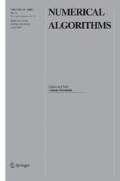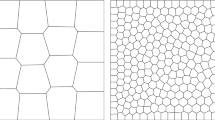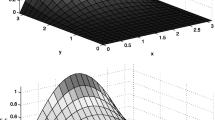Abstract
We propose and analyze a mixed virtual element method for time-fractional fourth-order subdiffusion equation involving the Caputo fractional derivative on polygonal meshes, whose solutions display a typical weak singularity at the initial time. By introducing an auxiliary variable σ = Δu, then the fourth-order equation can be split into the coupled system of two second-order equations. Based on the L1 scheme on a graded temporal mesh, the unconditional stability of the fully discrete is proved for two variables; and the priori error estimates are derived in L2 norm for the scalar unknown u and the variable σ, respectively. Moreover, the priori error result in H1 semi-norm for the scalar unknown u also is obtained. Finally, a numerical calculation is implemented to verify the theoretical results.

Similar content being viewed by others
References
Ahmad, B., Alsaedi, A., Brezzi, F., Marini, L. D., Russo, A.: Equivalent projectors for virtual element methods. Comput. Math. Appl. 66(3), 376–391 (2013)
Baleanu, D., Diethelm, K., Scalas, E., Trujillo, J. J.: Fractional Calculus: Models and Numerical Methods, 2nd edn. Series on complexity, nonlinearity and chaos, World Scientific, Singapore (2016)
Beirão da Veiga, L., Brezzi, F., Cangiani, A., Manzini, G., Marini, l., Russo, A.: Basic principles of virtual element methods. Math. Models Methods Appl. Sci. 23(1), 199–214 (2013)
Beirão da Veiga, L., Brezzi, F., Marini, L. D., Russo, A.: The hitchhiker’s guide to the virtual element method. Math. Models Methods Appl. Sci. 24(8), 1541–1573 (2014)
Beirão da Veiga, L., Brezzi, F., Marini, L. D., Russo, A.: Mixed virtual element methods for general second order elliptic problems on polygonal meshes. Math. Modell. Numer. Anal. 50(3), 727–747 (2016)
Beirão da Veiga, L., Brezzi, F., Marini, L. D., Russo, A.: Virtual element implementation for general elliptic equations. Build. Bridges: Connect. Challenges Modern Approach. Numer. Partial Differ. Equ. 114, 39–71 (2016)
Beirão da Veiga, L., Lipnikov, K., Manzini, G.: The Mimetic Finite Difference Method for Elliptic Problems. MS & A, Modeling Simulation and Applications, vol. 11. Springer, Berlin (2014)
Benedetto, M. F., Berrone, S., Borio, A., Pieraccini, S., Scialo, S.: Order preserving supg stabilization for the virtual element formulation of advection-diffusion problems. Comput. Methods Appl. Mech. Eng. 311, 18–40 (2016)
Brezzi, F., Falk, R. S., Marini, L. D.: Basic principles of mixed virtual element methods. Math. Modell. Numer. Anal. 48(4), 1227–1240 (2014)
Chen, H., Stynes, M.: Error analysis of a second-order method on fitted meshes for a time-fractional diffusion problem. J. Sci. Comput. 79(1), 624–647 (2019)
Chen, L., Wei, H., Wen, M.: An interface-fitted mesh generator and virtual element methods for elliptic interface problems. J. Comput. Phys. 334, 327–348 (2017)
Cáceres, E., Gatica, G. N.: A mixed virtual element method for the pseudostress–velocity formulation of the stokes problem. Ima J. Numer. Anal. 37(1), 296–331 (2017)
Dassi, F., Vacca, G.: Bricks for the mixed high-order virtual element method: Projectors and differential operators. Appl. Numer. Math. 155, 140–159 (2020)
Evans, L.: Partial Differential Equations, 2nd edn. American Mathematical Society providence, Rhode Island (2010)
Halpern, D., Jensen, O. E., Grotberg, J. B.: A theoretical study of surfactant and liquid delivery into the lung. J. Appl. Physiol. 85(1), 333–352 (1998)
Huang, C., Stynes, M.: α-robust error analysis of a mixed finite element method for a time-fractional biharmonic equation. Numerical Algorithms(2020) (2020)
Kopteva, N.: Error analysis of the L1 method on graded and uniform meshes for a fractional-derivative problem in two and three dimensions. Math. Comput. 88(319), 2135–2155 (2019)
Li, M., Zhao, J., Huang, C., Chen, S.: Nonconforming virtual element method for the time fractional reaction–subdiffusion equation with non-smooth data. J. Sci. Comput. 81(3), 1823–1859 (2019)
Liu, F., Zhuang, P., Liu, Q.: Numerical Methods of Fractional Partial Differential Equations and Applications. Science Press, Beijing (2015)
Luchko, Y.: Initial-boundary-value problems for the one-dimensional time-fractional diffusion equation. Fract. Calc. Appl. Anal. 15(1), 141–160 (2012)
Meng, J., Mei, L.: A mixed virtual element method for the vibration problem of clamped kirchhoff plate. Adv. Comput. Math. 46(5) (2020)
Myers, T., Charpin, J.: A mathematical model for atmospheric ice accretion and water flow on a cold surface. Int. J. Heat Mass Transf. 47(25), 5483–5500 (2004)
Podlubny, I.: Fractional Differential Equations. Academic Press, San Diego (1999)
Sakamoto, K., Yamamoto, M.: Initial value/boundary value problems for fractional diffusion-wave equations and applications to some inverse problems. J. Math. Anal. Appl. 382(1), 426–447 (2011)
Stynes, M., O’Riordan, E., Gracia, J. L.: Error analysis of a finite difference method on graded meshes for a time-fractional diffusion equation. SIAM J. Numer. Anal. 55(2), 1057–1079 (2017)
Vacca, G., Beirão da Veiga, L.: Virtual element methods for parabolic problems on polygonal meshes: Vem for parabolic problems. Numer. Methods Partial Differ. Equ. 31(6), 2110–2134 (2015)
Yang, X., Zhang, H., Tang, J.: The osc solver for the fourth-order sub-diffusion equation with weakly singular solutions. Comput. Math. Appl. 82, 1–12 (2021)
Zhang, B., Feng, M.: Virtual element method for two-dimensional linear elasticity problem in mixed weakly symmetric formulation. Appl. Math. Comput. 328, 1–25 (2018)
Zhang, B., Yang, Y., Feng, M.: Mixed virtual element methods for elastodynamics with weak symmetry. J. Comput. Appl. Math. 353, 49–71 (2019)
Zhong, J., Liao, H., Ji, B., Zhang, L.: A fourth-order compact solver for fractional-in-time fourth-order diffusion equations. arXiv:1907.01708 (2019)
Funding
This paper is supported by National Nature Science Foundation of China (Nos. 11971337, 11971416)
Author information
Authors and Affiliations
Corresponding author
Ethics declarations
Conflict of interest
The authors declare that they have no known competing financial interests or personal relationships that could have appeared to influence the work reported in this paper.
Additional information
Publisher’s note
Springer Nature remains neutral with regard to jurisdictional claims in published maps and institutional affiliations.
Rights and permissions
About this article
Cite this article
Zhang, Y., Feng, M. A mixed virtual element method for the time-fractional fourth-order subdiffusion equation. Numer Algor 90, 1617–1637 (2022). https://doi.org/10.1007/s11075-021-01244-0
Received:
Accepted:
Published:
Issue Date:
DOI: https://doi.org/10.1007/s11075-021-01244-0




